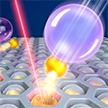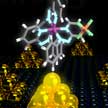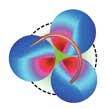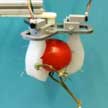Showing Spotlights 9 - 16 of 80 in category All (newest first):
 Researchers introduce spin orbit torque (SOT) devices to experimentally realize in-memory analogue mathematical operations such as summation, subtraction and four-quadrant multiplication, to implement general-purpose applications such as image or signal processing for edge computing. In addition to nonvolatility and scalability, the CMOS-compatible SOT technique further possesses low energy consumption, high speed and endurance. Therefore, SOT devices offer an avenue for dense in-memory analogue computing paradigms.
Researchers introduce spin orbit torque (SOT) devices to experimentally realize in-memory analogue mathematical operations such as summation, subtraction and four-quadrant multiplication, to implement general-purpose applications such as image or signal processing for edge computing. In addition to nonvolatility and scalability, the CMOS-compatible SOT technique further possesses low energy consumption, high speed and endurance. Therefore, SOT devices offer an avenue for dense in-memory analogue computing paradigms.
Aug 16th, 2022
 One convenient way to manipulate nanoscale objects with remote controllability is actuation and propulsion by light, which is largely based on optical and photothermal-induced forces. Unfortunately, the output of optical and photothermal-induced forces is small and speed is slow. This changes with a novel and intriguing nanoactuation system: plasmonic nanodynamite. This system can be optically triggered to eject gold nanobullets with an initial speed of up to 300 m/s.
One convenient way to manipulate nanoscale objects with remote controllability is actuation and propulsion by light, which is largely based on optical and photothermal-induced forces. Unfortunately, the output of optical and photothermal-induced forces is small and speed is slow. This changes with a novel and intriguing nanoactuation system: plasmonic nanodynamite. This system can be optically triggered to eject gold nanobullets with an initial speed of up to 300 m/s.
Aug 8th, 2022
 The controlled rotation of micro- and nanoscale objects plays a crucial role in sensing, imaging, biomedicine, and manufacturing. What makes light-driven micro- and nanorotors so promising for many applications is their non-contact, fuel-free operation. It has remained challenging for simple and low-power optics to achieve light-driven rotation of a wide range of objects, including optically symmetric synthetic particles and biological cells. A novel platform elegantly addresses this issue by achieving the rotation of various particles and live cells using an arbitrary low-power laser beam.
The controlled rotation of micro- and nanoscale objects plays a crucial role in sensing, imaging, biomedicine, and manufacturing. What makes light-driven micro- and nanorotors so promising for many applications is their non-contact, fuel-free operation. It has remained challenging for simple and low-power optics to achieve light-driven rotation of a wide range of objects, including optically symmetric synthetic particles and biological cells. A novel platform elegantly addresses this issue by achieving the rotation of various particles and live cells using an arbitrary low-power laser beam.
Jul 4th, 2022
 Magnetic manipulation of nano- and microscale objects is a remote and non-invasive technology with potentially numerous applications in material sciences and life sciences, such as for instance drug delivery. However, a limitation of this technology is that it can only be applied to certain materials with magnetic response, i.e., ferromagnetic or superparamagnetic materials. A new technique allows to incorporate magnetic nanoparticles onto the nonmagnetic skeleton.
Magnetic manipulation of nano- and microscale objects is a remote and non-invasive technology with potentially numerous applications in material sciences and life sciences, such as for instance drug delivery. However, a limitation of this technology is that it can only be applied to certain materials with magnetic response, i.e., ferromagnetic or superparamagnetic materials. A new technique allows to incorporate magnetic nanoparticles onto the nonmagnetic skeleton.
Feb 11th, 2021
 The biggest challenge for the development of brain-inspired computing is that the brain is too complex to simply emulate on a chip. Its massive interconnectivity, redundancy, local activity, remarkable logic complexity, and functional non-linearity makes the brain a computing masterpiece. Many researchers in this field see memristors as a key device component for neuromorphic computing. In particular, a non-conventional genre of memristors made of metal-organic molecular complexes shows great promise for ultralow energy, high density computing platforms.
The biggest challenge for the development of brain-inspired computing is that the brain is too complex to simply emulate on a chip. Its massive interconnectivity, redundancy, local activity, remarkable logic complexity, and functional non-linearity makes the brain a computing masterpiece. Many researchers in this field see memristors as a key device component for neuromorphic computing. In particular, a non-conventional genre of memristors made of metal-organic molecular complexes shows great promise for ultralow energy, high density computing platforms.
Nov 2nd, 2020
 Researchers have demonstrated the creation of a living micromotor with multifunctional capability. The distinctive feature of this device is that it doesn't require synthetic materials and therefore avoid the problems of energy consumption and waste production generated during material synthesis. Using microalgal Chlamydomonas reinhardtii cells as the sole material, the scientists made living and multifunctional micromotors controlled by optical force. This system might be particularly useful for indirect manipulation and controllable disruption of biological targets.
Researchers have demonstrated the creation of a living micromotor with multifunctional capability. The distinctive feature of this device is that it doesn't require synthetic materials and therefore avoid the problems of energy consumption and waste production generated during material synthesis. Using microalgal Chlamydomonas reinhardtii cells as the sole material, the scientists made living and multifunctional micromotors controlled by optical force. This system might be particularly useful for indirect manipulation and controllable disruption of biological targets.
Sep 23rd, 2020
 Researchers have exploited the opto-thermoelectric effect to develop a new type of all-optical microswimmers with active navigation functionality. These microswimmers consist of individual Janus particles - polystyrene beads half coated with gold nanoparticles - that can be directionally delivered over 22 times of their own diameters in 39 seconds. The opto-thermoelectric field triggers two working states - swimming and rotating - under different laser inputs. Combined with a feedback control algorithm to coordinate swimming and rotating states of the swimmers based on real-time imaging, precise all-optical navigation and target delivery becomes possible.
Researchers have exploited the opto-thermoelectric effect to develop a new type of all-optical microswimmers with active navigation functionality. These microswimmers consist of individual Janus particles - polystyrene beads half coated with gold nanoparticles - that can be directionally delivered over 22 times of their own diameters in 39 seconds. The opto-thermoelectric field triggers two working states - swimming and rotating - under different laser inputs. Combined with a feedback control algorithm to coordinate swimming and rotating states of the swimmers based on real-time imaging, precise all-optical navigation and target delivery becomes possible.
Aug 18th, 2020
 Grippers or end effectors are an essential tool integrated with robotic arms for implementing grasping and manipulating functions in a variety of tasks, ranging from picking up and holding objects, to digging and sorting, to locomotion and scratching. Engineers have developed a new kind of smart soft actuator, based on the triboelectric nanogenerator (TENG), to fabricate intelligent grippers for robotics, aiming at potential applications in the areas of agriculture, engineering and healthcare and beyond.
Grippers or end effectors are an essential tool integrated with robotic arms for implementing grasping and manipulating functions in a variety of tasks, ranging from picking up and holding objects, to digging and sorting, to locomotion and scratching. Engineers have developed a new kind of smart soft actuator, based on the triboelectric nanogenerator (TENG), to fabricate intelligent grippers for robotics, aiming at potential applications in the areas of agriculture, engineering and healthcare and beyond.
Jan 21st, 2020
 Researchers introduce spin orbit torque (SOT) devices to experimentally realize in-memory analogue mathematical operations such as summation, subtraction and four-quadrant multiplication, to implement general-purpose applications such as image or signal processing for edge computing. In addition to nonvolatility and scalability, the CMOS-compatible SOT technique further possesses low energy consumption, high speed and endurance. Therefore, SOT devices offer an avenue for dense in-memory analogue computing paradigms.
Researchers introduce spin orbit torque (SOT) devices to experimentally realize in-memory analogue mathematical operations such as summation, subtraction and four-quadrant multiplication, to implement general-purpose applications such as image or signal processing for edge computing. In addition to nonvolatility and scalability, the CMOS-compatible SOT technique further possesses low energy consumption, high speed and endurance. Therefore, SOT devices offer an avenue for dense in-memory analogue computing paradigms.
 Subscribe to our Nanotechnology Spotlight feed
Subscribe to our Nanotechnology Spotlight feed





